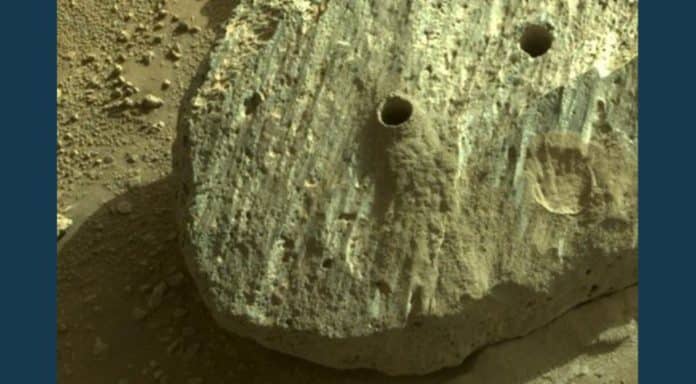
ORLANDO, Fla., Sept. 10 (UPI) — The first two rock samples examined by NASA’s Mars rover Perseverance give scientists a firm belief that water inundated Jezero Crater for a sustained period of time, the agency announced Friday.
“We determined salt granules in the rock indicate it was exposed to water,” Julia Goreva, a NASA scientist for the rover program, said in a news conference from the Jet Propulsion Laboratory in Pasadena, Calif.
The rocks, drilled Monday and Wednesday, came from an igneous or volcanic rock. The agency previously knew that water once filled the crater, but not for how long.
The salt deposits mean NASA can now rule out a sudden “flash in the pan” water event, the agency said in a news release.
“It looks like our first rocks reveal a potentially habitable sustained environment,” said Ken Farley, project scientist for the mission, said in the release. “It’s a big deal that the water was there a long time.”
The rover sampled a rock NASA dubbed Rochette on a ridge named Artuby. The two samples are named Montdenier and Montagnac after a French mountain and region, respectively.
Scientists chose the Rochette drilling site after a previous attempt to drill a sample failed because the brittle rock target crumbled.
The samples now are stored and sealed inside the rover as part of a multinational effort to bring Mars rocks back to Earth by 2031, said Kate Stack Morgan, Perseverance deputy project scientist.
The samples may be dropped on the Martian surface for a future rover to retrieve and launch into space, where another spacecraft would catch them and return them to Earth. Ultimately, the goal is to use advanced equipment on Earth to analyze the rocks for signs of ancient life on Mars.
“We plan to continue exploring Jezero Crater … for about two Earth years,” Stack Morgan said in the news conference. “We will make decisions then on which samples we’d like to put down in that first cache.”
The samples, about the thickness of a pencil, were 2.4 inches long and 2.6 inches long, which are nearly ideal, said Jessica Samuels, the Perseverance surface mission manager, at the Jet Propulsion Laboratory.
“Reflecting on this moment, it has been the culmination of so many years of so many people’s hard work and time and effort,” Samuels said.
“While it definitely was a very long time waiting, I think all of us can say that it feels fantastic to … be up here and share this with you.”






